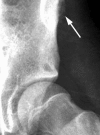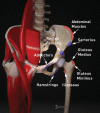Orthopaedic magnetic resonance imaging challenge: apophyseal avulsions at the pelvis
- PMID: 23015945
- PMCID: PMC3445104
- DOI: 10.1177/1941738109347976
Orthopaedic magnetic resonance imaging challenge: apophyseal avulsions at the pelvis
Abstract
Apophyseal avulsion injuries of the hip and pelvis are frequent athletic injuries in children and adolescents, most commonly associated with explosive movement or sprinting. This article details typically encountered apophyseal injuries and their appearance on magnetic resonance imaging.
Keywords: adolescent; apophyseal avulsion; hip and pelvis; magnetic resonance imaging.
Conflict of interest statement
No potential conflict of interest declared.
Figures












Similar articles
-
[Apophyseal Avulsions of the Hip Region in Adolescents].Orthopade. 2016 Mar;45(3):213-8. doi: 10.1007/s00132-016-3230-4. Orthopade. 2016. PMID: 26837511 Review. German.
-
[Radiological diagnosis of apophyseal injuries of the pelvic region].Radiologie (Heidelb). 2023 Oct;63(10):758-765. doi: 10.1007/s00117-023-01211-x. Epub 2023 Sep 18. Radiologie (Heidelb). 2023. PMID: 37721585 Review. German.
-
Avulsion injuries of the pelvis.Semin Musculoskelet Radiol. 2008 Mar;12(1):42-53. doi: 10.1055/s-2008-1067936. Semin Musculoskelet Radiol. 2008. PMID: 18382943 Review.
-
Diagnosis and treatment of apophyseal injuries of the pelvis in adolescents.Semin Musculoskelet Radiol. 2014 Nov;18(5):498-504. doi: 10.1055/s-0034-1389267. Epub 2014 Oct 28. Semin Musculoskelet Radiol. 2014. PMID: 25350828 Review.
-
[Apophyseal avulsions of the pelvis and proximal femur].Ugeskr Laeger. 1993 Jul 5;155(27):2124-5. Ugeskr Laeger. 1993. PMID: 8328062 Danish.
Cited by
-
Multimodality imaging evaluation for iliac crest apophysis avulsion injury.Radiol Case Rep. 2019 Jun 6;14(8):986-988. doi: 10.1016/j.radcr.2019.05.016. eCollection 2019 Aug. Radiol Case Rep. 2019. PMID: 31198480 Free PMC article.
-
[Apophyseal Avulsions of the Hip Region in Adolescents].Orthopade. 2016 Mar;45(3):213-8. doi: 10.1007/s00132-016-3230-4. Orthopade. 2016. PMID: 26837511 Review. German.
-
Magnetic Resonance Imaging in the Evaluation of Avulsion Injuries of the Pelvis and Hip in Adolescent Professional Footballers: A Case Series.J Orthop Case Rep. 2024 May;14(5):147-152. doi: 10.13107/jocr.2024.v14.i05.4466. J Orthop Case Rep. 2024. PMID: 38784877 Free PMC article.
-
Acute Avulsion of the Iliac Crest Apophysis in an Adolescent Indoor Soccer.J Belg Soc Radiol. 2015 Dec 30;99(2):20-24. doi: 10.5334/jbr-btr.876. J Belg Soc Radiol. 2015. PMID: 30039100 Free PMC article.
-
Iliac crest apophyseal insufficiency avulsion fractures.Ann R Coll Surg Engl. 2018 Jan;100(1):e4-e6. doi: 10.1308/rcsann.2017.0175. Epub 2017 Oct 19. Ann R Coll Surg Engl. 2018. PMID: 29046079 Free PMC article.
References
-
- Bencardino JT, Mellado JM. Hamstring injuries of the hip. Magn Reson Imaging Clin N Am. 2005;13:677-690 - PubMed
-
- Boyd KT, Peirce NS, Batt ME. Common hip injuries in sports. Sports Med. 1997;24(4):273-288 - PubMed
-
- Combs J. Hip and pelvis avulsion injuries in adolescents. Phys Sportsmed. 1994;22:41-49 - PubMed
-
- Cunningham PM, Brennan D, O’Connell M, MacMahon P, O’Neill P, Eustace S. Patterns of bone and soft-tissue injury at the symphysis pubis in soccer players: observations at MRI. AJR Am J Roentgenol. 2007;188:W291-W296 - PubMed
-
- Diehl JJ, Best TM, Kaeding CC. Classification and return-to-play considerations for stress fractures. Clin Sports Med. 2006;25:17-28 - PubMed
LinkOut - more resources
Full Text Sources

